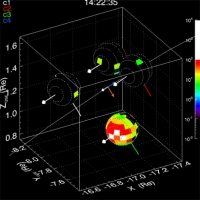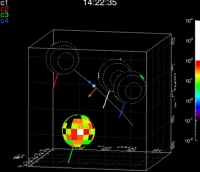Explosions, Plasmoids, Ion Beams - Report on 7th Cluster Workshop
15 March 2004
The Earth possesses an internal magnetic dynamo that generates a magnetic field that affects the motion of charge particles in space around the Earth. Under pressure from the solar wind, the shape of the Earth's magnetic field lines transforms from a dipolar form into a large comet-like form. The tail of this structure, also called the magnetotail, is understood to be an explosive region and a source of energetic particles; some of the particles are relativistic and can reach energies higher than 10 MeV.
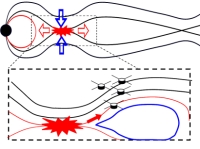 |
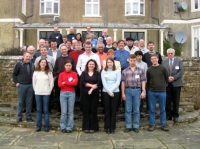 |
|
Dynamics of Earth's Magnetotail |
The Workshop Members |
About 40 Cluster scientists recently gathered for the 7th Cluster Workshop, also called the 2nd Cluster tail workshop, (3 -5 March 2004 at MMSL, Dorking, UK) to further investigate these events.
Explosions
One of the fundamental physical processes in the universe is magnetic reconnection. For scientists, somewhat fortunately, it occurs frequently in the Earth's magnetosphere. It is an explosive process, giving rise to a huge amount of energy that is drawn into the Earth's atmosphere by magnetic field lines. There are many unsolved issues in reconnection such as the triggering of the process and the formation of thin current sheet that is known to occur before reconnection takes place.
Between July and October 2003, the four Cluster spacecraft were in a tetrahedral formation separated by about 200 km. This is an ideal separation to resolve the structure of the thin current sheet obtained from the curlometer technique using magnetic field data from FGM instrument. Dr. Rumi Nakamura and her colleagues (Space Research Institute, Graz, Austria) have investigated the current sheet crossings observed on 17 August 2003. Indication of sheet crossings comes from a change of magnetic field component, Bx, from positive to negative (that is, the satellite is moving from the northern hemisphere into the southern hemisphere across the tail where Bx = 0), or vice versa. During each crossing the ion instrument detects fast ion flows. The fast tailward (-Vx) and Earthward flows (+Vx) suggest the occurrence of a reconnection process.
An example of a current sheet crossings event, at around 16:29 UT 17.10.2003, shows that the dawn-to-dusk current density (jy) obtained from the curlometer reached 140 nAm-2, which is about 30 times larger than the nominal value in this region. The estimated profile of the dawn-to-dusk current density along the Z direction shows that the half thickness of the tail current sheet is about 300 km. Since the region is about 10 000 km wide in the x direction, one can estimate that the total current flowing in this region is of the order of one million Amperes. When the thickness of the current sheet becomes this thin (less than the ion inertia scale length) the ion motions are no longer governed by the magnetic field and cannot be described as a fluid, while the electrons can be still behave as a fluid. As a result, it is believed that the dawnward motion of the electrons carries the current.
During the workshop, a detailed comparison took place between the current density obtained by the curlometer and the average current obtained by the PEACE electron instrument of the four spacecraft. The resulting good agreement confirmed the existence of a thin current sheet in the magnetotail carried mainly by the electrons.
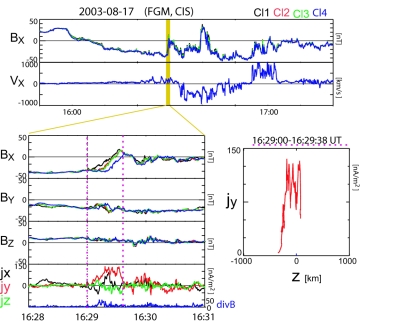 |
|
Magnetic Field and Ion Flow |
Plasmoids
The stretching of the Earths magnetic field through the influence of interactions with the solar wind forms the magnetotail. Variations in the IMF and solar wind incident on the magnetosphere induce large alterations into the magnetospheric system, changing its shape and configuration and altering the numerous current systems flowing within the magnetosphere.
This interaction creates a large energy reservoir in the magnetotail, in the form of the plasma sheet. Magnetospheric substorms dominate the dynamics of this region, which facilitate the rapid release of this energy via magnetic reconnection. This phenomenon involves the 'snapping' and re-configuring of magnetic field lines with an associated release of energetic particles.
The four spacecraft nature of CLUSTER facilitates the investigation of this three-dimensional phenomenon. Dr. Matt Taylor (Los Alamos National Laboratory, Los Alamos, USA) has investigated one such case that took place on 11 August 2002, where CLUSTER sampled an outflowing electron beam from a reconnection site. This is illustrated in the graphic, where the four spacecraft detect the growth and expulsion of a plasmoid. The lowest spacecraft was fortuitously positioned at the separatrix (red line) of the reconnection site and was therefore able to sample a highly energetic electron beam. The dynamics of the beam allows estimates on magnetic structure sizes and the current systems surrounding such regions.
Ion beams
The visible aurora in the atmosphere is the result of complex dynamical processes in the magnetotail. One of those processes is the generation and transport of ions from one space region to another. For about 30 years, it has been known that ions can be accelerated to high speeds in a collective manner in the magnetosphere. Understanding these processes and their contribution towards the creation of the aurora is one major goal of Space Physics.
Dr. Andreas Keiling and his colleagues (CESR, Toulouse) have investigated temporal and spatial aspects of ion beams, using multipoint measurements from the Cluster spacecraft fleet. With unprecedented clarity, he has shown the substructuring of ion beams into smaller scale structures (beamlets). These structures show several energy dispersions, that is, monotonic decrease or increase in energy against time. The analysis of these features will help in answering the questions of where and how the ion beams are generated. For example, the energy dispersion associated with the ion structures labelled A, B and C are indirect evidence that B and C are echoes of the structure A. That is to say that particles A have travelled along Earth's magnetic field lines towards the atmosphere and bounced back and forth between the ionosphere and either the opposite ionosphere or the current sheet in the tail of the magnetosphere. These ion beams must have travelled distances of over 100 Re (1 Re = 6370 km = Earth's radius) while staying in their formation.
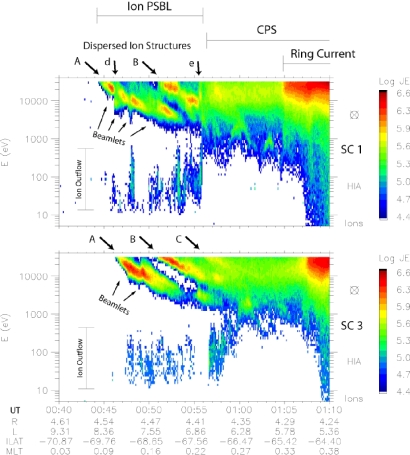 |
|
Ion Beams |
For more information, please contact:
Dr. Rumi Nakamura
Austrian Academy of Sciences
Space Research Institute
Graz
Austria
E-mail: rumi.nakamura oeaw.ac.at
oeaw.ac.at
Dr. Andreas Keiling
CESR
Toulouse
France
E-mail: Andreas.Keiling cesr.fr
cesr.fr
Dr. Matt Taylor
Los Alamos National Laboratory
Los Alamos
USA
mggtt lanl.gov
lanl.gov
Dr. Philippe Escoubet
ESA Cluster Project Scientist
ESTEC
Noordwijk
The Netherlands
E-mail: philippe.escoubet esa.int
esa.int
Dr. Harri Laakso
ESA Cluster Deputy Project Scientist
ESTEC
Noordwijk
The Netherlands
E-mail: harri.laakso esa.int
esa.int

